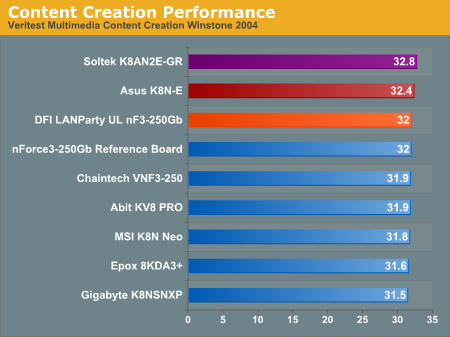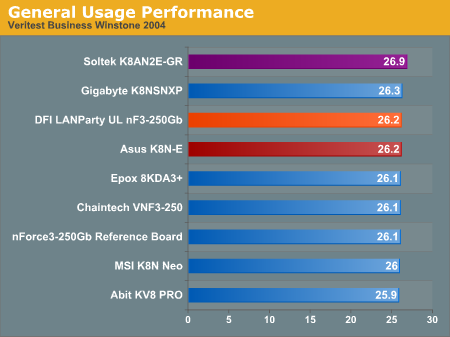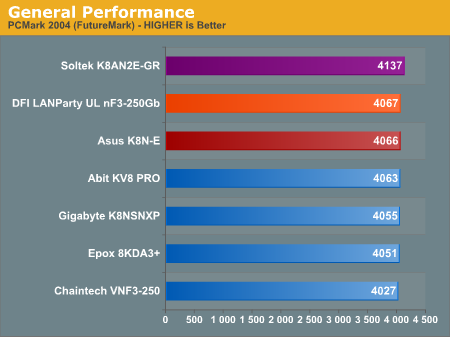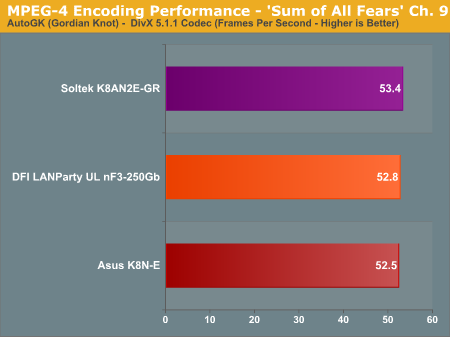Socket 754 Roundup, Part 3: Asus, Soltek & DFI
by Wesley Fink on September 14, 2004 12:03 AM EST- Posted in
- Motherboards
General Performance and Encoding




Values remain tightly clustered for 2nd generation 754 boards in Multimedia Content Creation and Business Winstone. It is interesting, however, that these most recent 754 boards are the boards at the top of the charts. It appears that Socket 754 has matured and manufacturers have learned to squeeze a bit more from the chipsets and processors.
The Soltek is a particularly fast performer at stock speeds. At a price of less than $100, it is a great value if you plan to run at stock and do not have a pressing need for on-board firewire.
The Soltek was a particular surprise in the 2-pass Media Encoding benchmark. In the past, we have seen values tightly clustered in boards using the same chipset and CPU. The Soltek even managed to top encoding by a skim margin. As we have stated in past reviews, the on-board memory controller of the Athlon 64 tends to make any differences between boards much smaller than what we have seen in the past with the memory controller on the chipset. So, variations in performance are more significant than they may first appear.










39 Comments
View All Comments
Staples - Tuesday, September 14, 2004 - link
I bought a 3200+ system a week ago and this Soltek board. I am glad to see that incomparison, this board's performance fairs really well. There is a big thread here and it seems quite a few people are experiencing various problems with it. Myself included. I think any potential buyer who is inticed by the cheap price might want to check it out before deciding on this one.Illissius - Tuesday, September 14, 2004 - link
Excellent review, and excellent boards. The only nitpick I have is that you say the three boards are constantly trading performance leads in the stock benchmarks; in reality, the Asus K8N-E and Soltek K8FNAEDKJL:DSGKJ3 trade wins and the DFI is usually behind them, where by a larger, where by a smaller margin, except for the Far Cry test where it manages to squeak a win by a fraction of a FPS.The DFI board is damn near perfect. There are only three minor problems with it: (1) The various stuff on the board that is glaring yellow is not blue instead; (2) It is not Abit; (3) It's slightly slower at stock speeds than the Asus and Soltek. Otherwise it's completely perfect, if I were buying a board right now it would absolutely be the one I'd choose.
One topic I'd like to see touched upon is support for mobile/DTR processors; mobiles AXPs were hugely succesful overclockers, but the mobile A64s are held back by almost universally substandard motherboard support for them. A 35W (1.2V) Mobile 2800+ coupled with the Lanparty UT would be pretty amazing, if it worked.
DoobieOnline - Tuesday, September 14, 2004 - link
Hey Wesley, that's weird that you couldn't get to 9x250 with a SATA drive on the Soltek. I'm using that board and running 10x250 with a 74GB Raptor on NVIDIA SATA 1. It's a great board for under $100! - doobiedevonz - Tuesday, September 14, 2004 - link
Just a thought. When you review memory modules you untimately produce comparison charts of the top overclocked performance of the modules. Why not have a set of graphs showing the top overclocked performance of motherboards so we can judge them based on that information too?icarus4586 - Tuesday, September 14, 2004 - link
It would have been interesting, just as a side-note, to see some tests on the DFI running at CAS 1.5, whether they were here or in the article on that board specifically. I've never seen any board/RAM that can run at 1.5-2-2LocutusX - Tuesday, September 14, 2004 - link
Regarding the Asus board:Wesley, is your A64 a Newcastle/CG revision or Clawhammer/C0? I have absolutely no issues running my Newcastle 3000+ @ 255FSB - it's like a rock. But yeah, I am using PATA.
Also, note that there is a new BIOS (1005) for the K8N-E which allows usage of 2.8v V_dimm on the 1.05 revision mobos.
jensend - Tuesday, September 14, 2004 - link
I think it would be interesting to see tests of how well different s754 chipsets and boards do with the Paris core Sempron.Wesley Fink - Tuesday, September 14, 2004 - link
The information in the Soltek Features table has been updated to reflect the latest BIOS values.Gundamit - Tuesday, September 14, 2004 - link
Price performance ratio is so much stonger for the 754. Thats why I decided to go for the DFI right now. In 6-8 months I'll take another look at the 939.The only dissapointment in the article was the fact you ran the 1.5 CAS setting but didn't post any results. Maybe it would have been out of place in a "roundup". BTW- Is still a round-up with only three mobos or cows? Maybe you could run some benchmarks and update the original LanpartyUT review?
ceefka - Tuesday, September 14, 2004 - link
If you haven't bought anything yet: The 754's only real disadvantage I can think of is its upgrade path or non existence thereof. It is still a very good platform. So what if it is limited to 2/3GB of RAM support. There are not many home users with 2GB+ of RAM.